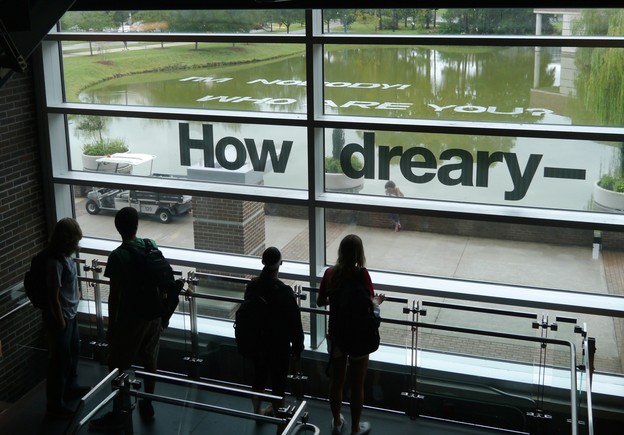Bright arrogance #5
'Extraordinary experience will not be locatable'

Emily Dickinson’s poetry is perhaps the closest thing canonical American literature has to a “sacred language.” In Robert Duncan’s lectures on Dickinson, we could say that he posits her as the ultimate untranslatable poet, even within her own language. In her poems she “bring[s] us to the line where everything is so fraught with meaning that we can’t find the meaning.” And so, even in a casual reading of her there is a dogged engagement with the translational sublime, performed with more or less sensitivity, because she is meaning something (Duncan is at pains to distinguish her gnomic utterances from the more postmodern disjunctions of language poetry), even if that something is a nothing that is legible. If the possibility of translation is assured by some structure of commonalities that all languages negotiate, these commonplaces are confounded in her Amherst garden. “Extraordinary experience will not be locatable,” Duncan says, and in particular extends the enigma of Dickinson’s work and its untranslatability to her sexual experiences with other women, which only could have been experienced through clear, positivistic, and communicative language in a cultural context that could readily explain them, or explain them away.
Compare, if you will, Paul Legault’s more impious description of Dickinson—in his preface to his volume of the complete English-to-English translations of her work—as “the father of American poetry and the most infamous lesbian vampire of the nineteenth century.”[1] No doubt he is announcing that he is about to replace the ineffable with something more effed. Michael Magee, in shaping Internet searches for Angie Dickinson into something that looks like Emily Dickinson but tastes like flarf, claims to want to return to the “shock, bewilderment, excitement, [and] pleasure . . . that [he] imagined Dickinson’s earliest readers must have felt.” Marie Buck’s translations plop the bookish belle in the more rowdy company of Baudelaire, Rimbaud and MySpace teens. Jen Bervin stitches composites of her strange punctuation and excised variants across large canvases of cotton batting. William Howe’s “translanations” map sound shapes of Dickinson’s poems, finding quasi-homophonic replacements that aim for the scatological rather than the absolute. For example, Dickinson’s
This World is not Conclusion.
A Species stands beyond—
Invisible, as Music—
But positive, as Sound—
It beckons, and it baffles—
Philosophy—don’t know . . .
becomes after Howe's translanational transformation:
Shit swirled blissed out concussion.
Aspic eyes brands buy fronds—
Enviable, azimuth—
Scut plausible hive, ass bound—
Henpeck ones, end shit waffles—
Philistine—donut— . . .
That’s not to say that these writers are not, in their barnstorming of the Dickinson archive, remaining “true” to her enigma. In fact, their faithfulness might be of a sort that necessitates such unconventional methods, attempting the impossible translation of Dickinson into English via what Charles Bernstein calls the “’pataque(e)rical imperative.” In future posts, I will be discussing in what ways the “vernacularism” of Legault might differ from the flarfism of W. Howe, Buck and Magee or the conceptualism of Bervin. Nevertheless, it is crucial to remember that at the heart of even (and especially) the most conservative volumes of Dickinson that certain “abusive” liberties have been taken to normalize punctuation and orthography, in addition to banishing some of the more odd poems. In a sense, these artists display an acute awareness that all versions of Dickinson are English-to-English translations, given that she seems to have cultivated a private language, unfiltered by the ministrations (and mistranslations) of editors. In fact, Dickinson never intended these poems to be published from the various sheaves and fascicles that were left at her death. With the recent publication of The Gorgeous Nothings: Emily Dickinson’s Envelope Poems there’s even a question of where poems end and marginalia begin, so that “poem” itself becomes a weird translation of what these nothings are.
~NEXT WEEK: THE VERNACULARISTS!!!~
1.While Legault's translation directly engages the imagery of zombies and vampires, he does not directly address these as possible invidious metaphors for the translator. While V. Joshua Adams, in his critique of domesticating translations (of which Legault's Dickinson is an extreme, perhaps parodic example), points to the ethnocentric violence and "vampiric incorporation of past epochs and books into the being of the present" . . . . Well, we like vampires, right? And aren't they the ultimate anti-domestic being? This might just be an instance of mixed metaphors, but Craig Dworkin gives a more (un)salubrious, or at least more complex take on the relation of vampirism to translation in this talk on Brandon Brown's Flowering Mall (And, in fact, throughout his oeuvre, Brown thematizes the relation of translator to translated as one of uncanny doubling.)
Bright arrogance